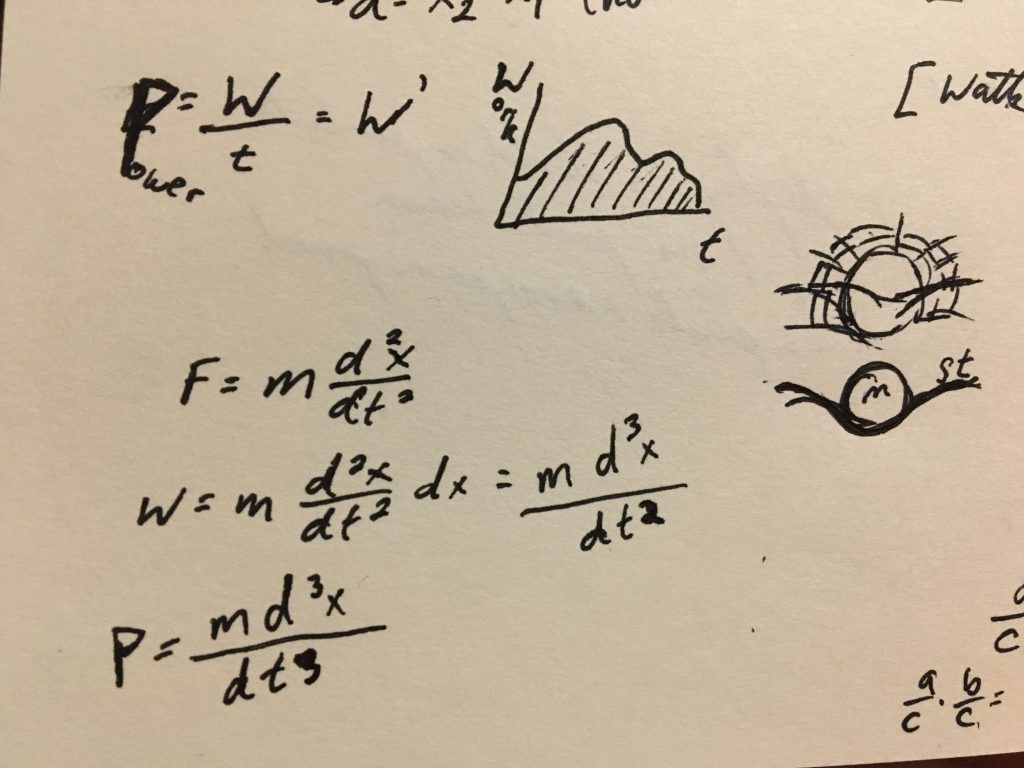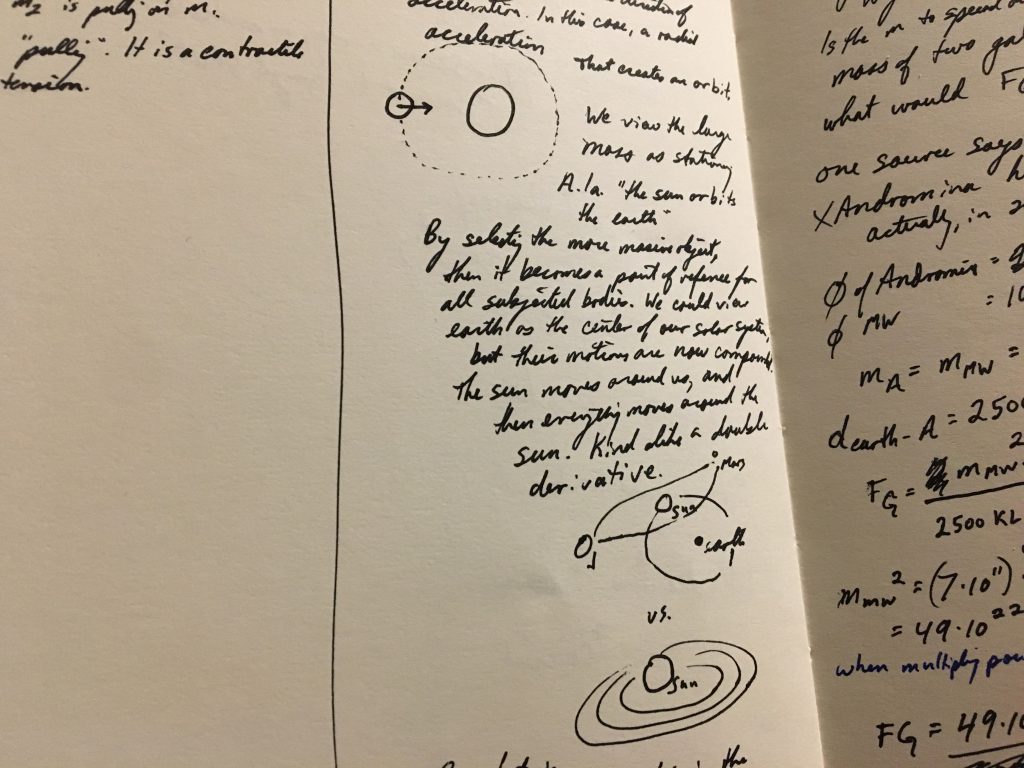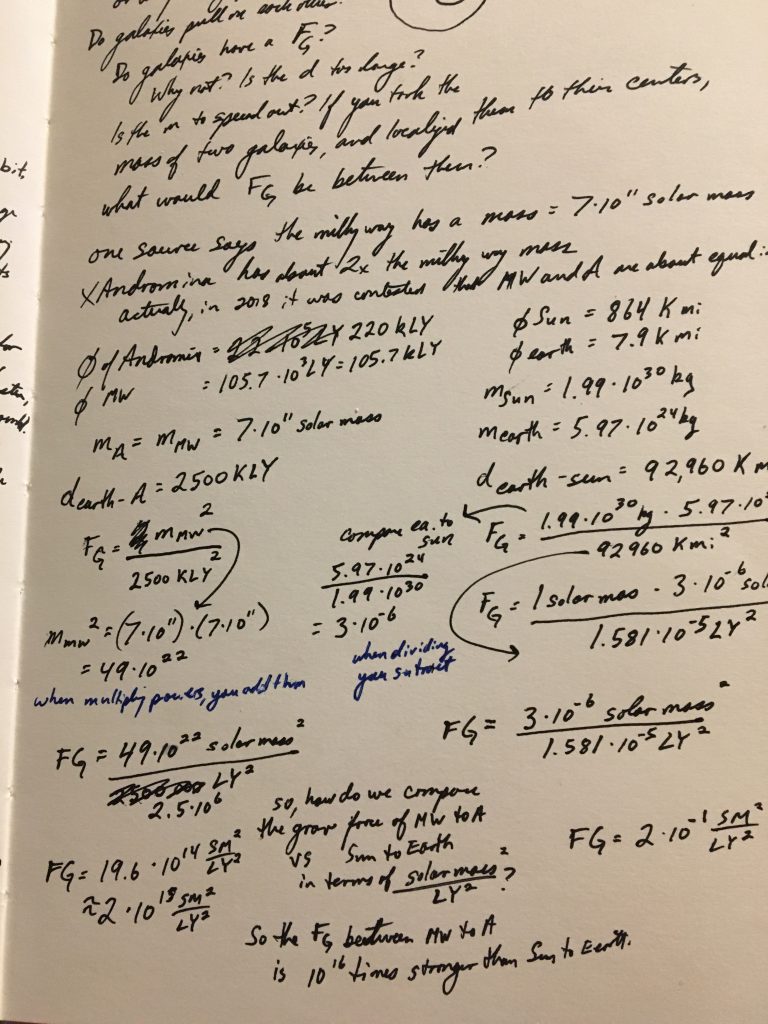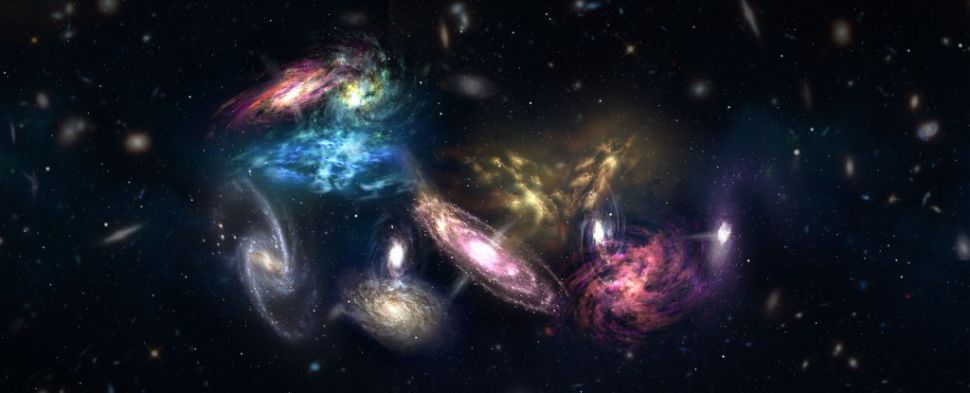What holds it all together? -or- Stroopwafel cookies
Diana recently introduced me to a cookie known as Stroopwafels. They are a delicious Dutch cookie made of two waffles sandwiching a caramel center. Consequently, these little cookies would start me down a line of questioning that would only end with me calculating the ratio of the gravitational force of our Sun to Earth over that of the Milky Way galaxy to Andromeda.

As I broke the cookie apart, strings of sugary caramel would pull apart under tension until they finally plastically deform and break. I noticed that if I were to rejoin these two segments along their break line that I could somewhat adhere them back together. Not as strongly as the cookie was before I broke it but strong enough to resist falling off due to gravity.
“What is adhesion?” I asked Diana. I assumed that was the phenomena I was witnessing. Seeing as Diana is a material scientist, I was hoping she could shed some light on the matter.
She wasn’t sure. We began debating it a little back and forth. Fortunately I didn’t have my phone with and it started developing more questions versus just a quick Google search/answer. Was the caramel a non-newtonian fluid? Is caramel water based? Does the hydrogen bonding of the water in the caramel affect the adhesion? As neither of us could quickly look up an answer this lead to a more exploratory line of questions than just blunt answers. I explained what cohesion was to Diana, demonstrating how a bead of water would… well, form a bead on a plate. How it would “stick” to itself while oil would not. I stuck a finger into my glass of water to demonstrate then transitioned to some of the oil left on my plate from the delicious salmon she cooked. I guess this counts as, yet again, playing with my food.
“So cohesion is a chemical force.” She asserted.
“Well, yes.” I answered. This got me thinking about sarcomeres and the cross-bridge cycles–the first principle elements of our skeletal muscle contraction. “I guess the tensile force of sarcomeres are also due to chemical forces… or is it kinetic? The proteins are moving. How do the sarcomere forces relate to the forms of potential energy? I don’t know that it necessarily makes sense as either kinetic, gravitational, or elastic potential energy.”
“No,” she continued, “It’s chemical. There’s more types of energy than what you just listed. That’s a limitation of your mechanical engineering background. There’s also heat.”
“Well, you mean ‘there’s also thermal energy.’ Heat is the transfer of that thermal energy. A limitation of your chemical engineering background.” It was a weak riposte. “But you’re right… I guess there are five forms of energy: gravitational, kinetic, elastic, chemical, and thermal. Or is thermal just kinetic? It is vibrating.”
At this point I got out my journal and revisited my calculus knowledge to–yet again–try to relate force, energy, and power into a set of common, basic elements. Diana took a more practical approach and generously cleared the table. I succeeded in a way, I think. I now view force, energy, and power as just different levels of derivatives given the common elements of mass, space, and time.

This lead me to again think about spacetime, and the perspective of how mass interacts with it (my cookie was gone at this point). By drawing it out, it became clear–again–to me that the acceleration due to gravity is in the same direction of the force, and given that the earth has inertia somewhat parallel to this acceleration, the acceleration acts as a radial acceleration. And thus, we orbit.
But we orbit the sun as much as the sun orbits us. Kinda. It’s correct to say that the sun experiences the same gravitational force as we do, given our relationship. I’ll just say that one of us is a little bit more on the heavy side.
But we could just as correctly take a perspective in which we view the sun as orbiting the earth. Indeed we did for many years, until a certain Italian with a telescope started to piss off the church. This creates a weird problem though. The other planets in our solar system orbit the sun. If we choose to view the sun as orbiting earth, then the other bodies in our solar system take on a kind of second derivative of orbit. I imagine that would be a nightmare for tracing out their motions. Then again… I’ve never navigated a ship without GPS, so I’m not one to talk.

But from an analytical viewpoint it seems to make sense to choose the most massive object in a group of celestial bodies as the grounding point.
So… what’s the most massive thing in the universe? The universe is expanding, right? Expanding from what? Andromeda and the Milky Way are going to collide in X years. That doesn’t seem like expansion to me. This all seems quite difficult to talk about on a universal scale without some kind of universal ground. Or is that a mute point? Are the galaxies so far apart that they don’t affect each other with gravitational force? Are they isolated systems, as far as we can tell?
Instead of just Googling such a weird question, I decided to try to discern it myself. I laid out the boundaries of the question by assuming that each of the two galaxies contained all of their mass in a single point. This would make it possible to do these calculations with pen and paper vs IBM’s Watson.
I began by finding the relationship between the mass of the two galaxies. Turns out that is a contested question. I guess I’m not completely surprised, it seems a hard one to answer. Post-2018, it is generally held that they are roughly the same mass. I proceeded with that assumption. I also found that the mass of the Milky Way is approximately 7*10^11 solar mass (the mass of our sun Sol). That would come in handy later.
Next I found the distance between the two galaxies. I was able to find the distance to the “Andromeda Galaxy” from Earth (granted it failed to mention what part of the Andromeda Galaxy that is) and I decided that would be good enough for these hand calculations. I found that in terms of light years.
I then turned my attention towards our mother star, Sol. She, conveniently, has a mass of 1 solar mass. Our mother planet is about 3*10^-6 solar mass. I then converted the distance between Sol and Earth from km to light years.
We now have similar units. Groovy. Do a little bit of division and you can find the gravitational force between Andromeda and the Milky Way in terms of [solar mass^2/light years^2]. You can do the same for Sol and Earth. I have absolutely no context for the size of that force, but we could then put the two forces in ratio to each other.
So, pause here for a moment. What do you think? Given this set up, which do you think is a larger force? Sure, the galaxies are huge compared to our humble home planet and star – but they are quite far apart, are they not? I don’t know if anyone besides an astronomer could make an informed guess. I certainly couldn’t. We don’t live at this scale. We don’t think in light years or anything really that is 10^30. Yet, still, given basic algebra, scientific notation, and knowledge about mass and distance – we can calculate an answer. Take a minute on it.

The answer… is that the galaxies exert a larger gravitational force on each other than the Sun does to Earth. Again, remember I am assuming all the mass in a single point for these two galaxies. The force is larger by quite a bit, actually. 10^16 times larger. So if the gravitational force of Sol and Earth is enough to put us in orbit, what does that mean for the two galaxies? Does it also matter what the ratio of the two bodies are to each other? The galaxies are about the same. Sol and Earth are very disproportionate. Is Andromeda and our galaxy in orbit of each other? Are there other nearby galaxies that are affecting us just as much? At what scale do things start/stop orbiting?
Which returned me, along this crazy string of questions that began with a cookie, to a question I had asked before. So I took this as an opportunity to conclude. I asked again, what is the most massive object in the universe?
It’s your mom.
That and a galaxy pileup of 14 merging galaxies known as SPT2349, which is quite beautiful.

This evening found a lot of questions, a few answers, but overall something I think more important. I’m glad I didn’t have my phone on me for most of this conversation/quest. I tried to figure some things out on my own given my memory of algebra and physics. Granted my phone was necessary for looking up masses and distances using Google, but up until that point I got to “wonder” a little bit at the answers. I guarantee I would not have followed the bread crumb trail of questions that would lead me to the SPT2349 had I just simply Googled “what is adhesion.”
Perhaps I’ll let a little more wonder into my life.

